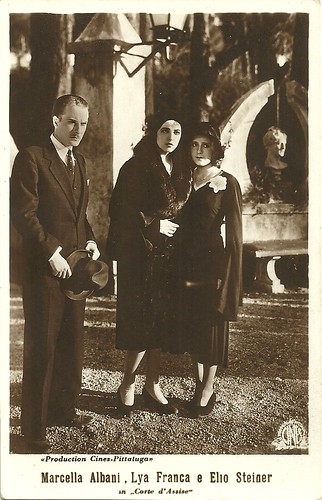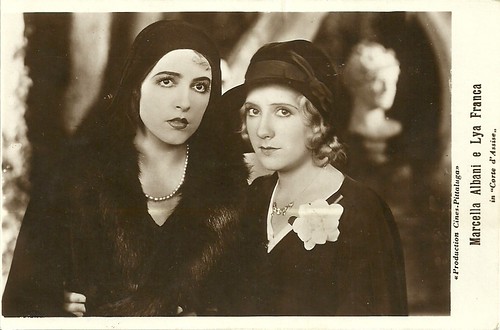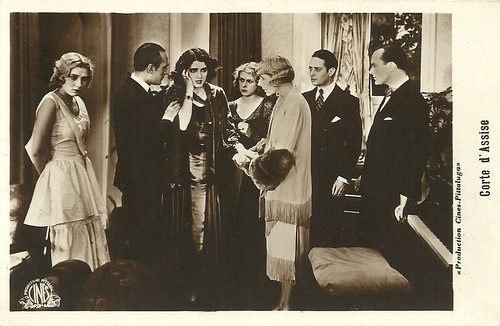Lia Franca aka Lya Franca (1912-1988) was an Italian film actress. After a breakthrough in 1930 and a peak in 1932 with Gli uomini che mascalzoni/What Rascals Men Are, she married and pulled the plug on her acting career.

Italian postcard. Photo: Cines-Pittaluga, Roma.

Italian postcard. Photo: Cines-Pittaluga. Marcella Albani, Lya Franca and Elio Steiner in Corte d'Assise/Before the Jury (Guido Brignone, 1930), the second Italian sound film, after La canzone dell'amore, and one the first Italian court case crime stories.
As Pietro Spirito wrote in Il Piccolo in 2010, Lia Franca is "emblematic and representative of an era of cinema in which the Italian star system was modelled on styles and ways of Hollywood’s star system".
She was baptised in the New Church of St. Anthony as Livia Caterina Petra Penso in 1912. When she was just 14, her compatriot Marcella Battellini won a competition organised by the Fox Film Corporation, looking for new faces to be launched in Hollywood cinema. The winners chosen from the approximately forty thousand men and thirty thousand women participants were respectively Alberto Rabagliati, who would become a popular Italian singer, and Marcella Battellini.
The news that a girl from Trieste could establish herself in the film gave way to a whole series of competitions. The first was the Miss Trieste pageant in 1927, with thousands of participants, won by Argelia Lazardi, Ermy Metlica and Livia Penso. On the contest also a short film was made, Il trionfo di Venere/The Triumph of Venus, projected from 20 to 23 May 1927 at the Cinema Corso in Trieste.
Livia then moved to Turin, where she tried to work for the company Anonima Stefano Pittaluga but failed and finally moved to Rome. There she debuted in 1930 as Lia Franca in the short film Arietta antica. Then she had one of the leads in the court case drama Corte d’Assise/Before the Jury (Guido Brignone, 1930), starring Marcella Albani, Franca and Elio Steiner.
After that, she performed in Resurrectio/Resurrection (Alessandro Blasetti, 1931), about an orchestra conductor (Daniele Crespi) who premeditates suicide because of his lover dumping him but then is held back by an innocent young girl (Franca), who inspires him and causes his resurrection. The film was Italy’s first feature sound film produced, but producers considered it better to release it after La canzone dell’amore, in 1931. The film was shot twice after the negative was burned and the film sequestered, but critics had no mercy and still condemned the film. Blasetti himself judged it his biggest flop.

Italian postcard. Photo: Produzione Cines-Pittaluga. Marcella Albani and Lya Franca in the court case melodrama Corte d'Assise/Before the Jury (Guido Brignone, 1930, released in 1931).

Italian postcard. Photo: Produzione Cines-Pittaluga. From left to right: Lya Franca, Renzo Ricci, Marcella Albani, and Mercedes Brignone, and at far right Elio Steiner, in Corte d'Assise/Before the Jury (Guido Brignone, 1930-1931).
Lia Franca then played a minor part in La stella del cinema/The Movie Star (Mario Almirante, 1931), starring Grazia Del Rio.
Franca finally got her big role as Mariuccia, the shopgirl, in the romantic comedy Gli uomini, che mascalzoni…/What Rascals Men Are (Mario Camerini, 1932). Here a young Vittorio De Sica dedicates the famous song 'Parlami d’amore, Mariù' to Franca’s Mariuccia. The film and the song were huge successes at the time, both inside and outside of Italy, turning De Sica into a full-blown film star.
An important innovation in a time when most Italian films were shot in studios was to have a great deal of the film shot in exteriors, in Milan and on the Lakes. The story deals with private chauffeur Bruno who pretends he owns the rich family's car and takes shopgirl Mariuccia to the lakes. He meets the family there who order him to drive them back to Milan, leaving Mariuccia behind. Afterwards, he crashes the car trying to pick up the girl left behind and is fired. After many more adventures, the two can finally reunite.
During the production of the film, Franca met the assistant director Mario Sequi. They married shortly after the premiere of their film. Lia abandoned the cinema forever and never spoke to the press again.
Lia Franca died in Rome in 1988.
Tribute to Lia Franca. Source: I MILLE OCCHI (YouTube).
Sources: La burbuja rosa (Italian - now defunct), Wikipedia (English and Italian) and IMDb.
This post was last updated on 8 April 2024.

Italian postcard. Photo: Cines-Pittaluga, Roma.

Italian postcard. Photo: Cines-Pittaluga. Marcella Albani, Lya Franca and Elio Steiner in Corte d'Assise/Before the Jury (Guido Brignone, 1930), the second Italian sound film, after La canzone dell'amore, and one the first Italian court case crime stories.
Miss Trieste
As Pietro Spirito wrote in Il Piccolo in 2010, Lia Franca is "emblematic and representative of an era of cinema in which the Italian star system was modelled on styles and ways of Hollywood’s star system".
She was baptised in the New Church of St. Anthony as Livia Caterina Petra Penso in 1912. When she was just 14, her compatriot Marcella Battellini won a competition organised by the Fox Film Corporation, looking for new faces to be launched in Hollywood cinema. The winners chosen from the approximately forty thousand men and thirty thousand women participants were respectively Alberto Rabagliati, who would become a popular Italian singer, and Marcella Battellini.
The news that a girl from Trieste could establish herself in the film gave way to a whole series of competitions. The first was the Miss Trieste pageant in 1927, with thousands of participants, won by Argelia Lazardi, Ermy Metlica and Livia Penso. On the contest also a short film was made, Il trionfo di Venere/The Triumph of Venus, projected from 20 to 23 May 1927 at the Cinema Corso in Trieste.
Livia then moved to Turin, where she tried to work for the company Anonima Stefano Pittaluga but failed and finally moved to Rome. There she debuted in 1930 as Lia Franca in the short film Arietta antica. Then she had one of the leads in the court case drama Corte d’Assise/Before the Jury (Guido Brignone, 1930), starring Marcella Albani, Franca and Elio Steiner.
After that, she performed in Resurrectio/Resurrection (Alessandro Blasetti, 1931), about an orchestra conductor (Daniele Crespi) who premeditates suicide because of his lover dumping him but then is held back by an innocent young girl (Franca), who inspires him and causes his resurrection. The film was Italy’s first feature sound film produced, but producers considered it better to release it after La canzone dell’amore, in 1931. The film was shot twice after the negative was burned and the film sequestered, but critics had no mercy and still condemned the film. Blasetti himself judged it his biggest flop.

Italian postcard. Photo: Produzione Cines-Pittaluga. Marcella Albani and Lya Franca in the court case melodrama Corte d'Assise/Before the Jury (Guido Brignone, 1930, released in 1931).

Italian postcard. Photo: Produzione Cines-Pittaluga. From left to right: Lya Franca, Renzo Ricci, Marcella Albani, and Mercedes Brignone, and at far right Elio Steiner, in Corte d'Assise/Before the Jury (Guido Brignone, 1930-1931).
Parlami d’amore
Lia Franca then played a minor part in La stella del cinema/The Movie Star (Mario Almirante, 1931), starring Grazia Del Rio.
Franca finally got her big role as Mariuccia, the shopgirl, in the romantic comedy Gli uomini, che mascalzoni…/What Rascals Men Are (Mario Camerini, 1932). Here a young Vittorio De Sica dedicates the famous song 'Parlami d’amore, Mariù' to Franca’s Mariuccia. The film and the song were huge successes at the time, both inside and outside of Italy, turning De Sica into a full-blown film star.
An important innovation in a time when most Italian films were shot in studios was to have a great deal of the film shot in exteriors, in Milan and on the Lakes. The story deals with private chauffeur Bruno who pretends he owns the rich family's car and takes shopgirl Mariuccia to the lakes. He meets the family there who order him to drive them back to Milan, leaving Mariuccia behind. Afterwards, he crashes the car trying to pick up the girl left behind and is fired. After many more adventures, the two can finally reunite.
During the production of the film, Franca met the assistant director Mario Sequi. They married shortly after the premiere of their film. Lia abandoned the cinema forever and never spoke to the press again.
Lia Franca died in Rome in 1988.
Tribute to Lia Franca. Source: I MILLE OCCHI (YouTube).
Sources: La burbuja rosa (Italian - now defunct), Wikipedia (English and Italian) and IMDb.
This post was last updated on 8 April 2024.
No comments:
Post a Comment